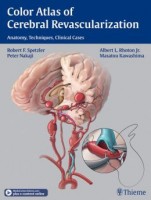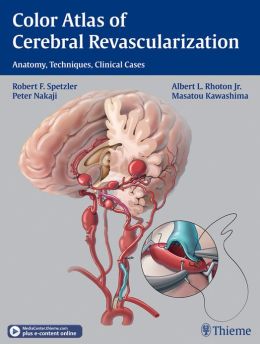 Authors: Robert F. Spetzler, MD, Peter Nakaji, MD, Albert L. Rhoton Jr., MD, and Masatou Kawashima
Authors: Robert F. Spetzler, MD, Peter Nakaji, MD, Albert L. Rhoton Jr., MD, and Masatou Kawashima
Publisher: Thieme
Book Review by: Nano Khilnani
Note to readers: This book comes with a DVD (located on inside back cover) containing over 30 related surgical cases narrated by Drs. Peter Nakaji and Robert F. Spetzler.
Cerebral revascularization is a set of techniques that neurosurgeons use to overcome the presence of, or potential for, ischemia n the brain.
Ischemia is the local loss of blood supply due to mechanical obstruction, mainly arterial narrowing or disruption of a blood vessel.
Ischemia can develop from several causes:
- Moyamoya disease
- Aneurysms that recur after coiling
- Giant aneurysms
- Vascular tears
- Vertebral artery insufficiency
- Severe vascular stenosis (narrowing of the blood vessel)
- Radiation-induced occlusion
In this atlas, the above-listed are the types of cases for which treatment is showcased. Dr. Spetzler points out that the most well-known example of revascularization is the surgical bypass. He states that the first known extracranial to intracranial (EC to IC) bypass using the superficial temporal artery (STA) and middle cerebral artery (MCA) was performed in 1967 by the neurosurgeons Donagy and Yasergil.
He writes that the use of the EC-to-IC bypass spread quickly until its efficacy was called into question in 1985. Aspects of this important issue are still being debated today, more than 25 years later, he observes, but he asserts that most neurosurgeons would agree that bypasses are “an integral part of the neurosurgical armamentarium.”
The STA-to-MCA bypass has become one of the most widely used of all bypasses for cerebral revascularization. Indeed, in this volume, STA-to-MCA bypasses represent the largest number of cases
Dr. Spetzler points out that the Barrow Neurosurgical Institute has the largest neurosurgical residency program in the United States. Besides STA-to-MCA bypass cases which have the largest representation among all revascularization procedures in this text, the others that are shown and discussed in it are:
- The bonnet bypass
- Middle meningeal artery-to-MCA bypass
- Onlay bypass
- Facial artery-to-vertebral artery bypass
- Internal maxillary artery-to-MCA bypass (the Abdulrauf bypass)
Other types of neurosurgical procedures are also covered in this book. One of the most wide-sweeping developments has been endovascular procedures. Dr. Spetzler discusses a case provided by Dr.Albert van der Zwan in which he used the excimer laser-assisted nonocclusive anastomosis or ELANA, a bypass procedure he developed without the need to interrupt the blood supply in the recipient blood vessels!
The Zwan bypass procedure was designed to reduce the incidence of a stroke or rupture of an aneurysm related to the temporary ischemia (loss of blood supply) induced in regions supplied by the artery receiving the bypass.
This book contains 16 sections which show, in full-color photos and through: detailed, intricate black-and-white and full-color sketches, angiograms, computer tomographs (CTs), magnetic resonance images (MRIs), and various other types of images, various surgical procedures.
The authors of this unique volume on cerebral revascularization have done an outstanding job with this book! They are:
Robert F. Spetzler, MD is Director of Barrow Neurological Institute, J.N.Harber Chairman and Professor of Neurological Surgery in the Division of Neurological Surgery at Barrow Neurological Institute in Phoenix, Arizona.
Albert L. Rhoton, Jr., MD is R.D. Keene Family Professor and Chairman Emeritus o of the Department of Neurosurgery at the University of Florida in Gainesville, Florida.
Peter Nakaji, MD, FACS, FAANS is Professor of Neurosurgery, Director of the Neurosurgery Residence Program, Director of Minimally Invasive Neurosurgery in the Division of Neurosurgery at Barrow Neurological Institute in Phoenix, Arizona.
Masatou Kawashima, MD, PhD is Associate Professor in the Department of Neurosurgery at the Faculty of Medicine at Saga University in Saga, Japan.







